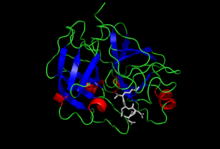Enteropeptidase
| enteropeptidase | |||||||||
|---|---|---|---|---|---|---|---|---|---|
 Crystal structure of Enteropeptidase with an
ExPASy NiceZyme view | | ||||||||
| KEGG | KEGG entry | ||||||||
| MetaCyc | metabolic pathway | ||||||||
| PRIAM | profile | ||||||||
| PDB structures | RCSB PDB PDBe PDBsum | ||||||||
| Gene Ontology | AmiGO / QuickGO | ||||||||
| |||||||||
| protease, serine, 7 (enteropeptidase) | |||||||
|---|---|---|---|---|---|---|---|
| Identifiers | |||||||
| Symbol | TMPRSS15 | ||||||
Chr. 21 q21 | |||||||
| |||||||
Enteropeptidase (also called enterokinase) is an enzyme produced by cells of the duodenum and is involved in digestion in humans and other animals. Enteropeptidase converts trypsinogen (a zymogen) into its active form trypsin, resulting in the subsequent activation of pancreatic digestive enzymes.[1][2] Absence of enteropeptidase results in intestinal digestion impairment.[3]
Enteropeptidase is a serine protease (EC 3.4.21.9) consisting of a disulfide-linked heavy-chain of 82-140 kDa that anchors enterokinase in the intestinal brush border membrane and a light-chain of 35–62 kDa that contains the catalytic subunit.[4] Enteropeptidase is a part of the chymotrypsin-clan of serine proteases, and is structurally similar to these proteins.[5]
Historical significance
Enteropeptidase was discovered by
Enzyme structure
Enteropeptidase is a type II transmembrane serine
In the case of cattle enteropeptidase the primary translation product comprises 1035 residues with an expected mass of 114.9 kDa.[11] The detected apparent mass of about 160 kDa is consistent with the specified carbohydrate content of 30 - 40%, with equal amounts of neutral and amino sugars.[12][13] The activation cleavage site after Lys800 splits the heavy and light chains of mature cattle enteropeptidase. There are 17 potential N-linked glycosylation sites in the heavy chain and three in the light chain; most of these are conserved in other species. The heavy chain has a hydrophobic section near the N-terminus that supports the transmembrane anchor.[14][15] The heavy chain influences the specificity of enteropeptidase. Native enteropeptidase is resistant to soybean trypsin inhibitor. However, the isolated light chain is subtle whether prepared by limited reduction of the natural protein[16] or by mutagenesis and expression in COS cells.[17] Native enteropeptidase and the isolated light chain have similar activity toward Gly-(Asp)4-Lys-NHNap, but the secluded light chain has distinctly decreased activity toward trypsinogen . An analogous selective defect in the recognition of trypsinogen can be produced in two-chain enteropeptidase by heating or by acetylation.[18] This behavior implies that the catalytic center and one or more secondary substrate-binding sites are essential for optimal recognition of trypsinogen.

Activity
Despite its alternative name (enterokinase), enteropeptidase is a serine protease that catalyses the hydrolysis of peptide bonds in proteins and, unlike other
trypsinogen → trypsin + pro-region (Val-Asp-Asp-Asp-Asp-Lys)
Genetics and disease relevance
In humans, enteropeptidase is encoded by the TMPRSS15
Applications
Enteropeptidase's specificity makes it an ideal tool in biochemical applications; a fusion protein containing a
References
- PMID 19873112.
- ISBN 978-0-12-122703-6.
- PMID 2658218.
- S2CID 25387669.
- PMID 8439290.
- PMID 10493881.
- PMID 13328891.
- ISBN 978-0-12-382219-2. Retrieved February 20, 2014.
- S2CID 254189.
- PMID 11060317.
- PMID 8052624.
- PMID 889800.
- PMID 762166.
- PMID 6338012.
- PMID 9395456.
- PMID 6386810.
- PMID 8226855.
- PMID 12810.
- ^ S2CID 206934268.
- PMID 19872978.
- PMID 11719902.
- PMID 4180366.
- PMID 4322674.
- PMID 8962677.
External links
- Enteropeptidase at the U.S. National Library of Medicine Medical Subject Headings (MeSH)
